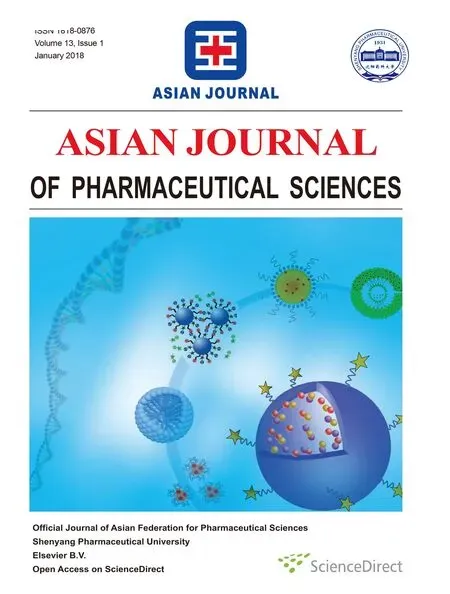Original Research Paper The accelerated blood clearance phenomenon of PEGylated nanoemulsion upon cross administration with nanoemulsions modified with polyglycerin
2018-03-12YuqingSuLirongWangKaifanLiangMengyangLiuXinrongLiuYanzhiSongYihuiDeng
Yuqing Su,Lirong Wang,Kaifan Liang,Mengyang Liu,Xinrong Liu,Yanzhi Song,Yihui Deng*
Shenyang Pharmaceutical University,No.85,Hongliu Road,Benxi 117004,China
1. Introduction
The use of PEGylated nanocarriers is a milestone breakthrough in the field of drug delivery due to its important application for increasing the serum stability and blood circulation time[1–3].However,an unexpected pharmacokinetic issue,the so-called accelerated blood clearance(ABC)phenomenon,has been revealed afterwards[4–10].In this phenomenon,anintravenousinjectionofPEGylatednanocarriers causes a second dose of PEGylated nanocarriers,which are injected a few days later,to be accumulated in liver resulting in the lost of long-circulating character of the PEGylated nanocarriers.Therefore,theABC phenomenon can reduce the therapeutic ef fi cacy of the encapsulated drugs,alter tissue distribution pattern of the drugs and cause some other adverse effects.For these reasons,how to eliminate the ABC phenomenon has garnered much interest and become a research focus.
Over the past decades,several excellent alternative materials have been reported,such as hemoglobin[11–13],biomimetic red blood cell membrane[14,15],sixth generation of lysine dendrimer[16],poly(amino acid)-poly(hydroxyethyl-l-asparagine)[17],poly(N-vinyl-2-pyrrolidone)[18,19],cleavable PEG-cholesterol derivatives[20],poly(sarcosine)60-block-(l-Leu-Aib)6[21],poly(carboxybetaine)[22–24],and et.al[25–34].These materials can decrease even eliminate the ABC phenomenon.As reported,polyglycerol is a more hydrophilic polymer than PEG,and can reduce the uptake by the mononuclear phagocyte system[35].In addition,1,2-distea-royl-sn-glycero-3-phosphoethanolamine-n-polyglycerine-760(PG-760)eliminates the ABC phenomenon of liposomes and ensures the effective delivery doxorubicin to the target site upon repeated administration[33].Moreover,repeated injection of the pDNA–lipoplex modified with PG-760 cannot induce the ABC phenomenon and can accumulate in tumor ef fi ciently[34].Although PG760 can eliminate theABC phenomenon in a repeated injection regimen,but more work needs to be done in the fi eld of studying theABC phenomenon associated with nanocarriers coated with other kind of polyglycerine.
In this work,the ABC phenomenon of the 1,2-distea-roylsn-glycero-3-phosphoethanolamine-n-polyglycerine-610(PG610-DSPE)has been studied.We fi nd that the nanoemulsions modified with the PG610-DSPE can induce the ABC phenomenon of the second dose of PEGylated nanoemulsions(PE),and the nanoemulsions modified with lower density of PG-610 can induce stronger ABC phenomenon.Through the in vivo tracing experiment and exhausted macrophages rat model,as expected,we con fi rm that the liver accumulation level of the fi rst dose has positive relationship with the intensity of theABC phenomenon.The kupffer cells(KCs)in liver not only play a“cleaner”role in the fi nal stage,but also as an external information “getter”or“transporter”in the early steps of the ABC phenomenon.This result is quite agreed with the conclusion proposed by Dams group[4],Ishida group[36–38]and our group[39].In addition,the blocking out polyhydroxy structure experiment reveals that the KCs in liver can get more immune information from the polyhydroxy structure than polycarboxyl group in the modify compound.The KCs deliver the information to other part of the immune system and fi nally increases the blood clearance ability.We propose that the modi fi er which contains polycarboxyl structure has chance to eliminate theABC phenomenon.In addition,preclinical studies of new materials modi fi ed nanocarriers should include the all-sided cross injection regimen with PEGylated nanocarriers,because the long circulation carriers such as PEGylated nanoemulsions which can amplify some weak signal of immunology changes can be a good ABC phenomenon detector.
2. Materials and methods
2.1. Materials and animals
1,2-distea-royl-sn-glycero-3-phosphoethanolamine-npolyglycerine-610(PG610-DSPE,NOF corporation,Japan);1,2-distearoyl-sn-glycero-3-phosphoethanolamine-n-[methoxy(polyethylene glycol)-2000](mPEG2000-DSPE,Genzyme,USA);Egg phosphatidylcholine(E80,Lipoid GmbH,Germany);Hydrogenated soy phosphatidylcholine(HSPC,Avanti polar lipid,USA);Cholesterol(CH,National medicines corporation,China);Medium-chain triglycerides(MCTs,Beiya Medicated Oil,China);Dialkylcarbocyanines(DiR,AAT Bioquest,USA);Triethylamine(TEA,Tianjin Bodi chemistry,China);Dichloromethane(DCM,Zhengxin high-tech research institute,China);Succinic acid anhydride(SAA,Zhengxin high-tech research institute,China);N,N-Dimethylamino-2-pyridine(DMAP,Tianjin Bodi chemistry,China);Alendronate sodium(AD,Beijing HWRK chem,China);Dimethyldioctadecylammonium bromide(DDAB,Sigma-aldrich,China);Sigma 1 KDa MWCO cellulose ester membrane(Sigma-aldrich,China);Sephadex G-50(Sigma-aldrich,China);Male Wistar rats(180–200 g,the experimental animal center of Shenyang Pharmaceutical University,China).All animal care and experiments were carried out according to the guidelines of the animal welfare committee of Shenyang Pharmaceutical University.
2.2. The structural transformation of the PG610-DSPE
The PGC was synthesized using PG610-DSPE and SAA with the DMAP/TEA as catalyst(Fig.1A).Brief l y,PG610-DSPE(30 mg,mM),TEA(10µl,mM)and DMAP(6.7 mg,mM)were dissolved in 4 ml DCM which contained SAA(54.7 mg)and stirred for 30 min in ice water bath.Then the reaction temperature was elevated to room temperature.After the reaction processed for 24 h under nitrogen,the mixture was diluted and fully dialyzed against water using a cellulose ester membrane of 1 KDa MWCO.The retentate was then lyophilized to yield the final product,which was analyzed by1H NMR(Bruker 600-MHz)using DMSO as the solvent and FT-IR(Bruker IFS 55)using KBr as the reference.
2.3. The preparation of the nanoemulsions
The oil phase containing DiR,MCTs,E80 and PG610-DSPE/mPEG2000-DSPE/PGC was dissolved at 55°C.Sterile water was quickly injected into this oil phase with stirring for 10 min at 55°C in a water bath to obtain the primary emulsions.The final emulsions were obtained by using a laboratory ultrasonic cell pulverizer(JY92-II,Ningbo Scientz Biotechnology,Zhejiang,China)at 200W for 2 min and at 400W for 6 min,respectively.Thefinalemulsionswereextrudedthroughpolycarbonatemembranes with a pore size of 0.22µm respectively,and were made isotonic with 50%(m/v)glucose(Shandong Yuwang industry,China).The nanoemulsions modified with 1 mol%,3 mol%or 9 mol%PG610-DSPE were named as 1%GE,3%GE 9%GE respectively.The nanoemulsion modified with 9 mol%mPEG2000-DSPE was named as 9%PE.The nanoemulsion modified with 1 mol%PGCwasnamedas1%HE.Thenanoemulsions,1%GE,3%GE9%GE,9%PE and 1%HE,were used as detection nanocarriers for containing DiR in the formulations.The empty nanoemulsions for the first injection in repeated injection regime were prepared using the similar formulations without DiR.These empty nanoemulsionswerenamedas1%GE-B,3%GE-B,9%GE-B,9%PE-B and 1%HE-B.The particle size distribution and Zeta potential were determined by dynamic light scattering using a Nicomp 380 HPL submicron particle analyzer(Particle Sizing Systems,SantaBarbara,CA,USA)andtheresultsareshownintheTable1.
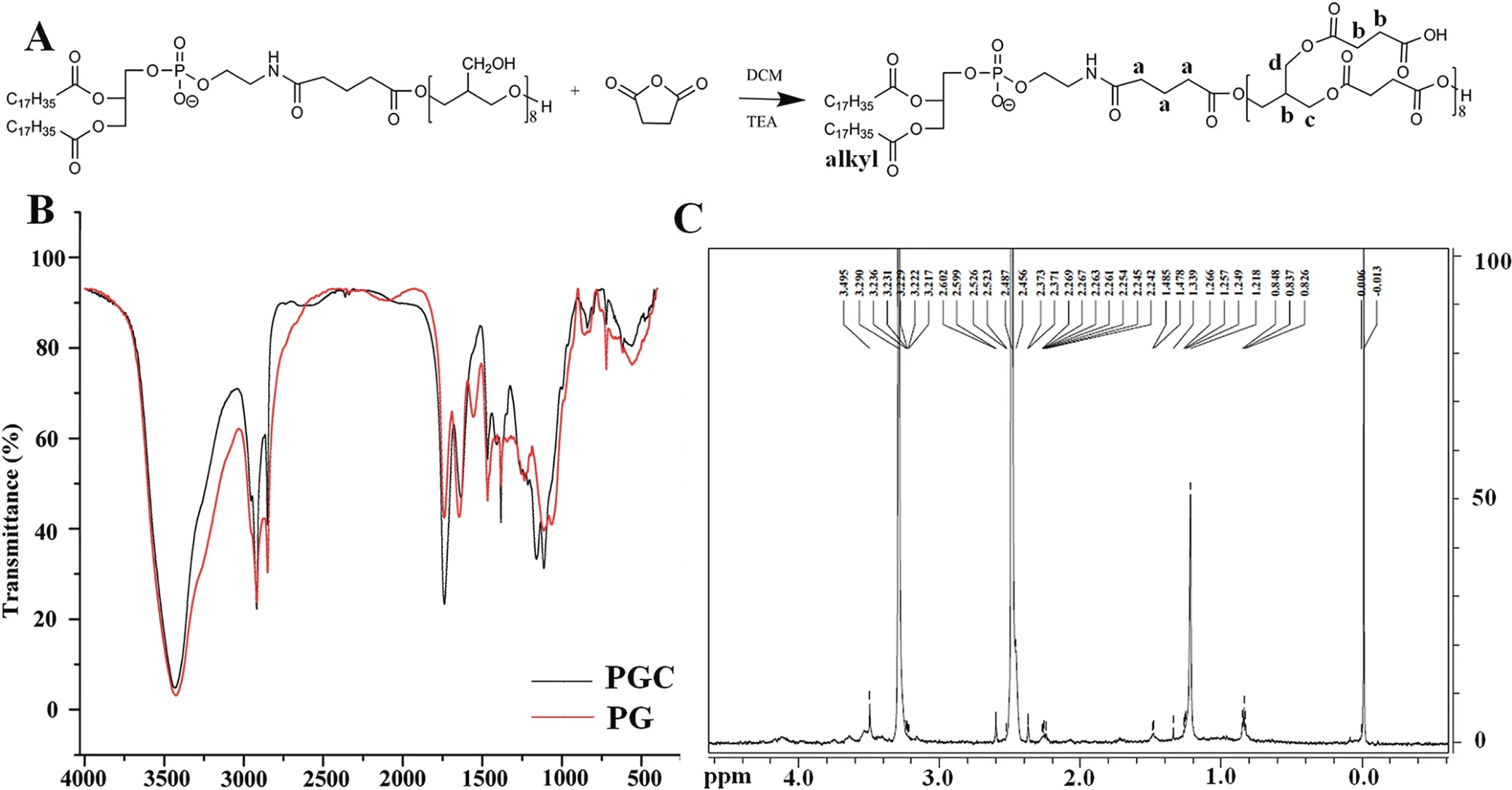
Fig.1–PGC synthesized by esterification reaction of PG610-DSPE and SAA with TEA as catalyst and DCM as organic solvent.The characterization of the PGC was measured by FT-IR and 1H NMR.(A)The structural formula PGC.(B)FT-IR spectra of PGC and PG.(C)1H NMR spectrum of PGC.
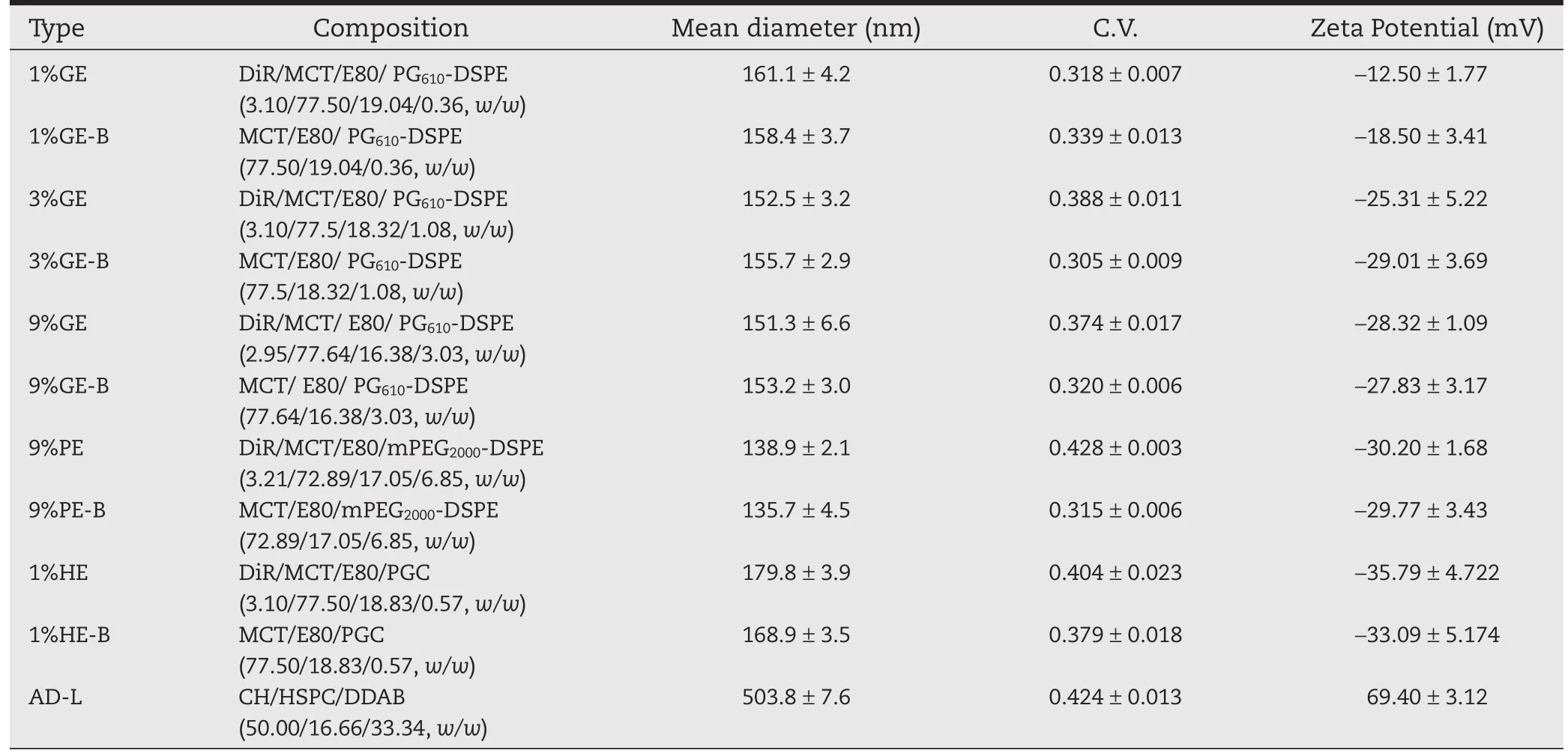
Table 1–The characteristics of nanoemulsions.
2.4. The preparation of the alendronate liposome
Alendronate liposome(AD-L)was prepared using passive loading method with a combination of the extrusion method.Brief l y,the lipid mixture(Table 1)was dissolved in 5 ml ethanol in 250 ml round-bottom f l ask.Added micro glass beads into the f l ask and then used RE52CS spin steaming instrument(Shanghai yarong biochemical instrument plant,China)to evaporate it at 60°C to near dryness.The resulting lipid film was hydrated with 5 ml AD solution at 60°C for 20 min under fast stirring.After hydration,the dispersion was extruded through 0.8µm and then 0.6µm polycarbonate films three times by LIPEX extrusion apparatus(Northen lipid,Canada).For removing non-encapsulated drug,the liposome was passed through a Sephadex G-50 column eluted with 5%glucose.The mean diameter and Zeta potential of AD-L were determined by Nicomp 380 HPL submicron particle analyzer.The formulation,size and Zeta potential of AD-L are shown in the Table 1.
2.5. The determination of the encapsulation efficiency
The AD-L preparation was taken and the unentrapped AD was removed by Sephadex G-50 chromatography to determine the encapsulation efficiency(%EE).The%EE was assessed by high performance liquid chromatography-evaporative light scattering detection(HPLC-ELSD,Chromatographic column:Kramasil C8column;Mobile phase:n-butyl amine:acetonitrile(9:1,v/v);Drift tube temperature:50°C;Air carrier gas pressure:3.0 bar)using a standard curve method.Brief l y,the 0.1 ml sample was loaded onto a Sephadex G-50 minicolumn(~20 mm)and then eluted them using 5%glucose.We calculated the concentration of AD which was entrappped into the liposome(Clip).Another 0.1 ml sample was dissolved by demulsifier containing 90%(v/v)isopropyl alcohol and 1.0 M HCl.We calculated the total concentration ofAD(Ctot).The%EE was calculated using this equation:EE%=(Clip/Ctot)×100%.
2.6. The pharmacokinetic and the ABC phenomenon studies of the nanoemulsions
In order to study the pharmacokinetic of nanoemulsions,the 1%GE,3%GE,9%GE and 9%PE prepared at a dose of 5µmol phospholipid/kg were injected via tail vein injection into rats respectively.At selected post-injection time points,0.083,0.25,0.5,1,2,4 h,blood was sampled through marginal veins of the eye.The liver and spleen were sacrificed after withdrawing the last blood sample at 4 h and rinsed with saline.Then these tissues were stored at−20 °C.When studied the ABC phenomenon,5µmol phospholipid/kg of the first injections,1%GE-B,3%GE-B,9%GE-B and 9%PE-B,were injected intravenously via the femoral vein respectively.Control group received 5%(m/v)glucose solution.7 d later,the second injection,9%PE,was administered intravenously via the femoral vein at a dose of 5µmol phospholipid/kg.Similarly,blood was sampled through marginal veins of the eye at time points,0.083,0.25,0.5,1,2,and 4 h.The liver and spleen were sacrificed after withdrawing the last blood sample at 4 h,rinsed with saline and stored at−20 °C.
2.7. The in vivo tracking of the nanoemulsions
Rats were divided into four groups and these rats were administered with 1%GE,3%GE,9%GE and 9%PE at the dose of 5µmol phospholipid/kg by tail vein injection respectively and anesthetized with pentobarbital.At 15,30,60,240,and 480 min after the injections,the sedated animals were then imaged using the in vivo optical imaging system and near-infrared fl uorescence(NIRF)probe(DiR,0.65 mg/kg).The detection wavelengths were 750 nm(excitation)and 790 nm(emission).
2.8. The effect of macrophage depletion
For the first injections,rats were injected with the 1%GE-B,3%GE-B,9%GE-B(5µmol phospholipid/kg)respectively via tail vein injection.5 d after the first injection of the non-labeled nanemulsions,each group received the AD-L(i.v.,AD 3 mg/kg),and then two days later,the rats were intravenously administered 9%PE(5µmol phospholipid/kg),which was injected intravenously via the femoral vein.Control group was pretreated with 5%(m/v)glucose solution.Blood samples were collected at multiple time points after the 9%PE injection(0.083,0.25,0.5,1,2,and 4 h)and the rats in each treatment group were euthanized at 4 h.Liver and spleen were excised,rinsed with saline,and stored at−20 °C.
2.9. The effect of changing hydrophilic group in modified phospholipids
Rats were intravenously administered the 1%HE(5µmol phospholipid/kg)in order to study the pharmacokinetic of nanoemulsions.After the injection,at selected post-injection time points(0.083,0.25,0.5,1,2,and 4 h),blood was sampled through marginal veins of the eye.The liver and spleen were sacri fi ced,rinsed with saline and stored at−20 °C.When studied the ABC phenomenon,the fi rst injection,1%HE-B,at the doses of 5µmol phospholipid/kg,was injected intravenously via the femoral vein.Control group received 5%(m/v)glucose solution.After 7 d,9%PE(5µmol phospholipid/kg),was administered via the femoral vein.As described above,at post-injection time points,0.083,0.25,0.5,1,2,and 4 h,blood was sampled through marginal veins of the eye.The liver and spleen were sacrifi ced,rinsed with saline,and stored at−20 °C.
2.10. The method for detecting DiR concentration in the tissue samples
The plasma samples and tissue samples were treated as follows:100µl of the plasma samples were mixed with ethylalcohol(900µl);200µl homogenates(equivalent to 0.1 g tissue)were mixed with ethylalcohol(800µl);the entire mixture was vortexed for 5 min and centrifuged at 10 000 rpm for 10 min;the supernatant(600µl)was centrifuged at 10 000 rpm for 10 min again;the final supernatant(200µl)was added into 96 plates and analysised by a microplate reader(Bio-Rad Laboratories,Hertfordshire,UK).The detection wavelengths were 750 nm(excitation)and 790 nm(emission).
2.11. Statistical analysis
The statistical analysis was performed using unpaired Student’s t-test with SPSS 16.0(IBM,Armonk,NY,USA)software for statistically testing whether the central tendencies of two groups are different from each other on the basis of samples of the two groups.A two-sided P value,P<0.05 was considered significant.The f l uorescence intensity was calculated using the carestream MI SE(Carestream,USA).The data are presented as the means±standard deviation.
3. Results and discussion
3.1. Synthesis and characterization of the PGC
As shown in the Fig.1A,PGC was synthesized via the esterifi cation reaction of PG610-DSPE and SAA.Comparing the red and black lines in the Fig.1B(FT-IR spectra),we can fi nd that a new absorption peak at 1739/cm(C=O)appears.Moreover,the absorption peaks at 1162.3/cm and 1142.3/cm(C-O-C)become stronger.These results reveal that new ester bond has formed.The absorption peak at 3426/cm(-OH)becomes shaper and the absorption peaks at 1559.8/cm and 1236.8/cm(hydrogen bond)disappear,indicating that the hydroxyl number decreases and the combined water in polyhydroxyl structures disappears.The structure of PGC is also con fi rmed by1H NMR(DMSO,dppm):0.83(t,6H,alkyl),1.00~1.20(s,52H,alkyl),1.30(m,4H,alkyl),1.40 ~ 1.50(m,4H,alkyl),2.1~2.3(s,10H,H-a,alkyl),2.3~2.7(m,44H,H-b),3.10~3.4(t,28H,H-c),3.55(d,14H,H-d)(Fig.1C).Therefore,we can con fi rm that the polyhydroxyl structures have been blocked by carboxyl and the PGC has been synthesized successfully.
3.2. The characterization of nanoemulsions
The average sizes of the GE,PE,PL,HE and AD-L are about 155 nm,140 nm,120 nm,175 nm and 500 nm respectively.Moreover,the size distributions of all the formulations stay in a low level for the coefficient of variation(C.V.)ranging from 0.318 to 0.428.Except the AD-L,all nanoemulsions are negatively charged for E80 molecule,mPEG2000-DSPE,PG610-DSPE and PGC at physiological pH.TheAD-L is positively charged for DDAB at physiological pH.From the Zeta potential results,modifying agents have coated on the surface of nanoemulsions successfully(Table 1).In addition,the EE%of the AD-L measured by Sephadex G-50-HPLC-ELSD method is 1.3%.
3.3. The pharmacokinetics of GE
As reported,increasing the PG760-derived lipid concentration from 5 to 15 mol%does not significantly affect the pharmacokinetic profile and organ distribution of PG760-coated liposomes[33].In this study,we treated rats with the 1%GE,3%GE and 9%GE at the dose of 5µmol phospholipid/kg,and the pharmacokineticparametersandorgandistributionwereevaluated.As shown in the Fig.2A,increasing the PG-derived lipid concentrationfrom1 mol%to9 mol%,thepharmacokineticprofi les do not have signi fi cant changes.Table 2 revealed that,the AUC(0–60min)values for the 1%GE,3%GE and 9%GE are comparable(1224.44±24.65,1746.27±22.83 and 2201.15±27.37µg/ml min respectively)(P > 0.05).%GE(MRT(0–∞),10.93 ± 1.23 min)is not signi fi cantly shorter than that of the 3%GE(MRT(0–∞),11.83±0.96 min)(Table2).Thecirculationtimecannotbefurther prolonged when the modi fi ed density to 9 mol%(MRT(0–∞),12.47±1.54 min)is increased.Compared with the 1%GE,the 9%PE prolongs the circulation signi fi cantly(***P<0.005).The AUC(0–60min)value of the 9%PE is 5723.06 ± 85.14 µg/ml/min.The Fig.2B reveals that the liver and spleen accumulations of PE are larger than those of the GE groups.
3.4. The ABC phenomenon of the GE
For evaluating the effect of PG610-DSPE on the induction of the ABC phenomenon in rats,rats were treated with the 1%GE-B,3%GE-B,9%GE-B and 9%PE-B at 5µmol phospholipid/kg as the fi rst dose respectively.7 d later,the rats were injected with the 9%PE(5µmol phospholipid/kg).The result of Fig.3A showed that,the plasma concentrations of the second dose of the 9%PE decrease.Compared with control group which pretreated with 5%glucose,rats pretreated with the 1%GE-B induce the rapidly clearance of the 9%PE(AUC(0–60min)values,5723.06 ± 85.14 and 1236.65±27.23µg/ml/min,respectively,**P<0.01,Table 2).The decreasingextendsfromstrongtoweakare1%GE>3%GE>9%GE(MRT(0–60)(min),19.45±1.54,22.48±2.12,23.49±2.76 min respectively).This suggests that theABC phenomenon is induced by the nanoemulsion coated with PG610-DSPE.This is the fi rst report that the GE induces theABC phenomenon of the second dose of the 9%PE.As shown in the Table 2,pharmacokinetic parameters reveal that rats pretreated with the 9%PE-B can inducestrongerABCphenomenonthanthe1%GE-B(AUC(0–60min)values,204.15±9.38 and 1236.65±27.23µg/ml/min,respectively).Theparametersbetweenthecontrolgroupandthegroup pretreated with the 1%GE-B are compared.The differences in parameters between these two groups are signi fi cant(**P<0.01)(Table 2).The Fig.2B shows that the liver and spleen accumulations are increased due to the induction of the ABC phenomenon.As we all know,PEG endows the nanoparticles“stealth”.Some researchers think that the reason why the PEGylated nanoemulsion induces theABC phenomenon is that the long lifetime of nanoparticles trigger the immune system[40].However,from the results of our work,the ABC phenomenon is also induced by the nanocarriers in short circulation.
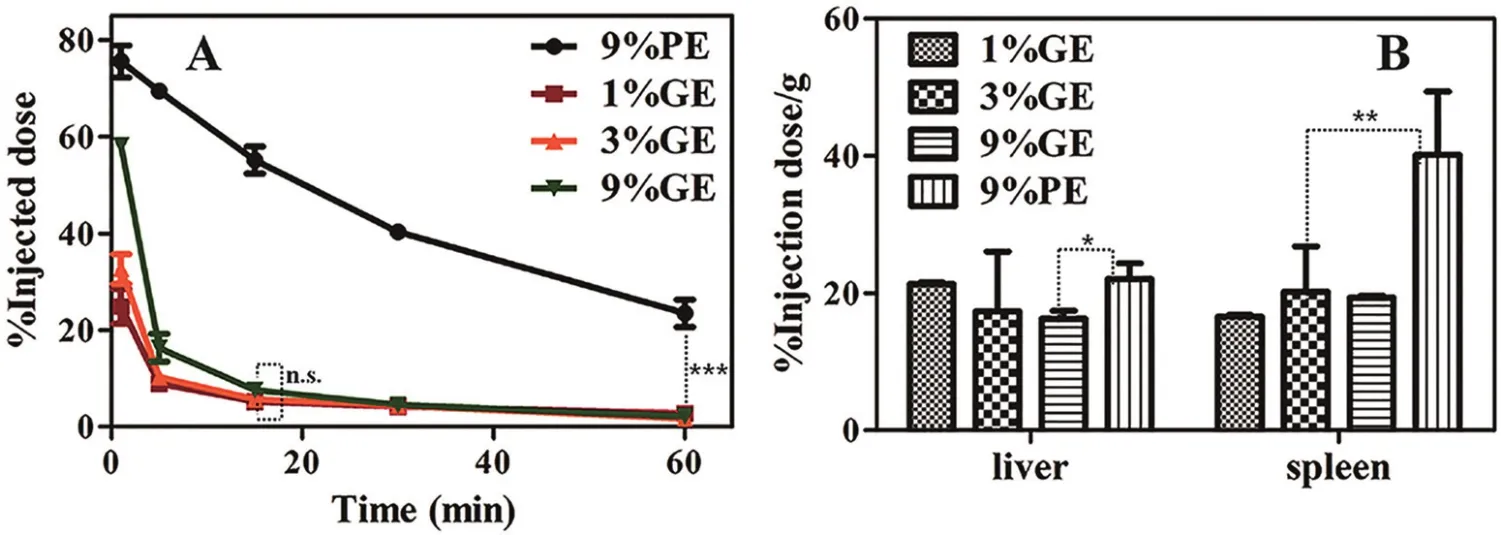
Fig.2–The pharmacokinetic profiles and organ distributions of intravenous injected nanoemulsions(1%GE,3%GE,9%GE and 9%PE)at the dose of 5µmol phospholipid/kg in rats,n=3.(A)Plasma concentration of the PE/GE.(B)Tissue concentration of the PE/GE.Each value represents the mean±SD of three animals.n.s.P>0.05,*P<0.05,**P<0.01,***P<0.005.
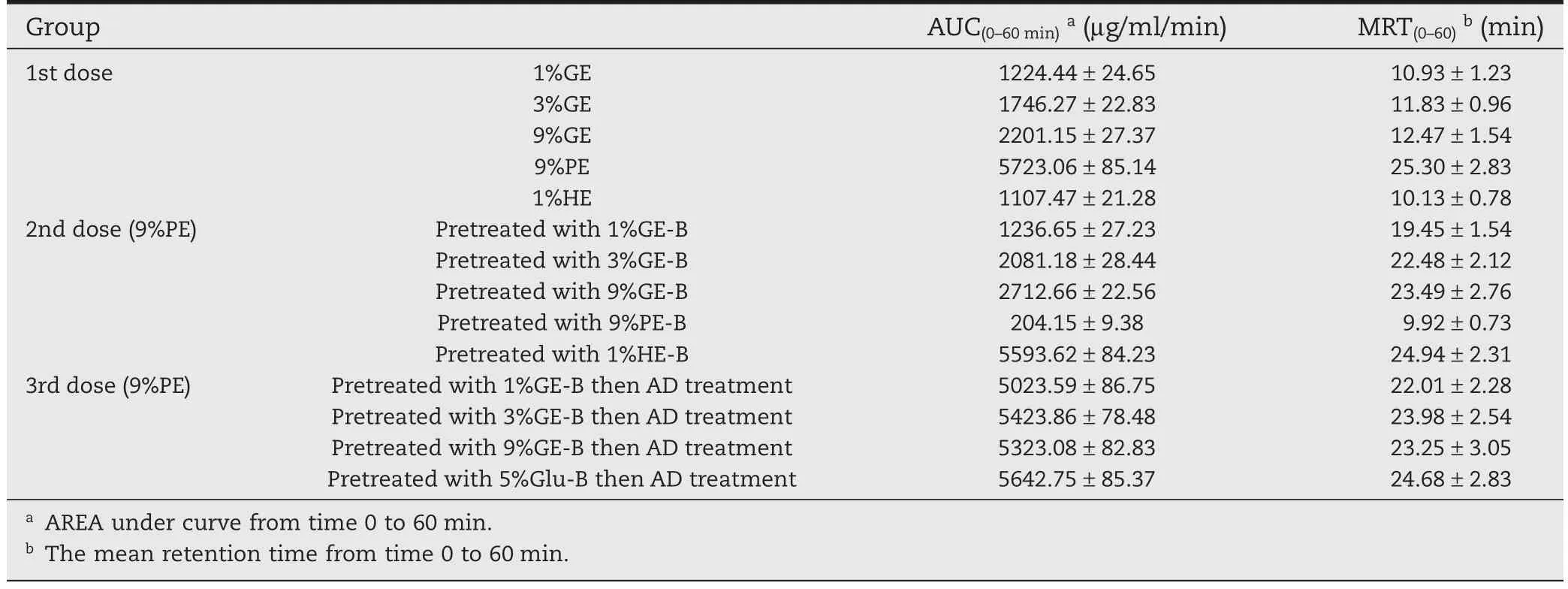
Table 2–Pharmacokinetic parameters of formulations.
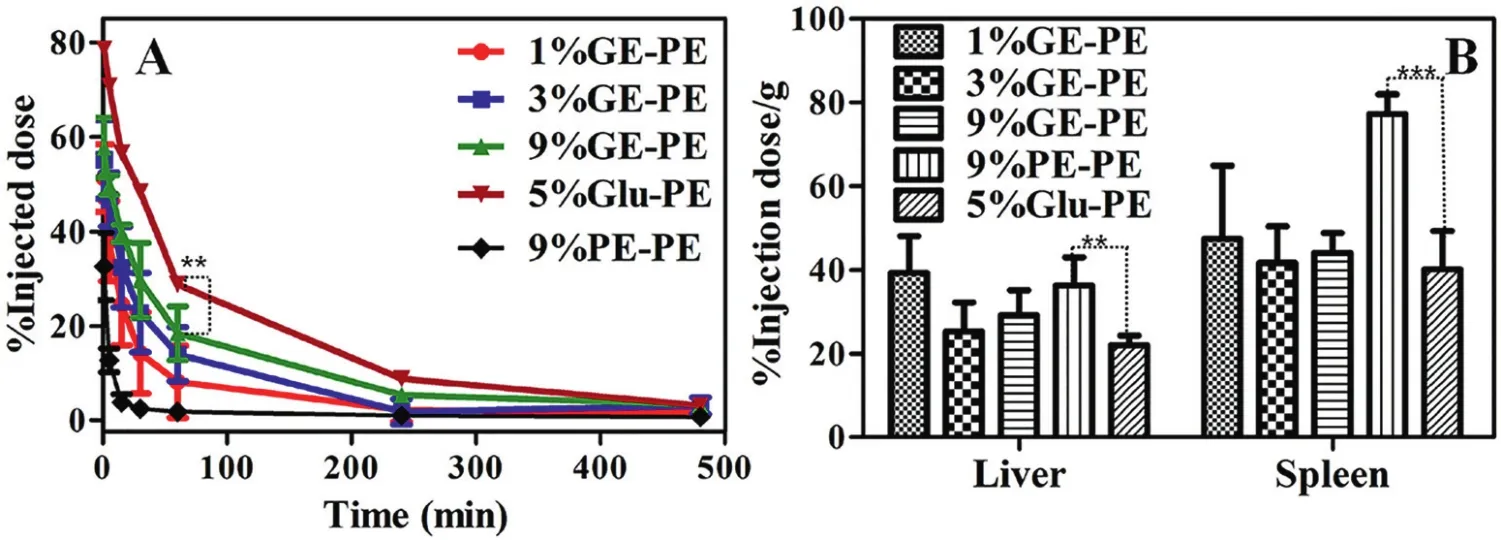
Fig.3–The effect of the first dose of none labeled nanoemulsions(5µmol phospholipid/kg),the 1%GE-B,the 3%GE-B,the 9%GE-B and the 9%PE-B,to the second dose of the 9%PE(5µmol phospholipid/kg),n=3.(A)Plasma concentration of the second dose of the 9%PE.(B)Tissue concentration of the second dose of the 9%PE.Each value represents the mean±SD of three animals.**P<0.01,***P<0.005.
3.5. The in vivo tracking of the nanoemulsions
In order to find the reason why the GE can induce the ABC phenomenon of the second dose of the PE,we studied the tissue distributions of nanocarriers by the optical in vivo imaging method.As shown in the Fig.4A,the nanoemulsions spread over the whole body.The tissue distributions of the 1%GE,3%GE,9%GE and 9%PE are quite different.Compared with 9%PE,nanoemulsions modified with the PG610-DSPE trend to accumulate into the joint,and are easily metabolized and excrete from the urinary system.That is the reason why the circulation time of the GE is shorter than the PE and why the liver accumulation of the GE is not higher than the PE at the time of 4 h after the first injection.However,9%PE which has“stealth”feature prefer to accumulate in the liver region.The liver accumulations from more to less are 9%PE>1%GE>3%GE>9%GE and that are also approved by the Region-of-interest(ROI)analyses(Fig.4B).We conclude that liver accumulation due to mononuclear phagocyte system plays an important role in the induction of theABC phenomenon by the GE to the second dose of the 9%PE.
3.6. The effect of macrophage depletion
The mechanism of the ABC phenomenon described as follows:the fi rst dose of PEGylated nanocarriers which acts asTI-2 antigens[38,41–43]contacts with the B-cells located in the splenic marginal zone[43],to secrete the anti-PEG IgM;the anti-PEG IgM binds to the second dose of the PEGylated liposome,activating complement and increasing uptake of opsonized nanoparticles by resident liver macrophages[44–49].Laverman group reported that when macrophages are depleted before the fi rst and second injections,the second injection of PEGylated liposomes has a normal long circulation time.This reveals that macrophages are involved in the production of the ABC phenomenon[5].In addition,it is also clear that the splenectomized rat fails to completely reverse the ABC phenomenon[36].Ishida group speculated that macrophages,including the KCs,acquire the ability to recognize and aggressively take up PEGylated liposomes[37,38].Furthermore,Ishida group also proposed that,the first dose PEGylated liposomes do not increase the intrinsic phagocytic activity of the KCs and the additive effect of activated liver macrophages and complement activation may exist in the ABC phenomenon[50].In this study,we also find that the liver communication has positive relationship with the ABC phenomenon from in vivo tracing experiment.We confirm that,the KCs in liver induce the ABC phenomenon at the initial phase.
For studying the effect of the mononuclear phagocyte system in liver in the ABC phenomenon,the depletion of the KCs were determined following the first administration of various GE.Firstly,rats in different groups were given the 1%GE-B,3%GE-B and 9%GE-B respectively.5 d later,each group was assigned to the AD-L treatments of AD 3 mg/kg.Then two days later,each group was administrated with the 9%PE(5µmol phospholipid/kg).For the control group,the first two injections were the 5%Glu and the third injection was the 9%PE.The result shows that,for the AD-L treatments,the first injection of the GE only slightly inf l uence the plasma concentration and the tissue distribution of the second dose of the 9%PE(Fig.5).Pharmacokinetic parameters were also determined.As shown in the Table 2,the AUC(0–60min)values of the second dose of the 9%PE are 5023.59±86.75,5423.86±78.48 and 5323.08±82.83 respectively.The differences in parameters for the control group and the group pretrated with the 1%GE-B are not significant(P>0.05).This suggests that the KCs can play an important role in the induction phase of the ABC phenomenon.

Fig.5–The effect of the macrophage depletion in the ABC phenomenon induced by GE.rats in different groups were given the 1%GE-B,3%GE-B and 9%GE-B respectively.5 d later,each group was assigned to the AD-L treatments of AD 3 mg/kg.Then 2 d later,each group was administrated with the 9%PE(5µmol phospholipid/kg).For the control group,the first two injections were the 5%Glu and the third injection was the 9%PE,n=3.(A)Plasma concentration of the second dose of the 9%PE.(B)Tissue concentration of the second dose of the 9%PE.Each value represents the mean±SD of three animals.n.s.P>0.05.
3.7. The effect of changing hydrophilic group in modified phospholipids
In order to find out the immune signals that the KCs receives from the GE,we replaced the polyhydroxy structure with polycarboxylic group and named this new compound as PGC.Interestingly,nanoemulsions modified with the PGC cannot decrease the plasma concentration of the second dose of the 9%PE and only slightly increase the tissue accumulation(Fig.6).From pharmacokinetic parameters,the MRT(0–60)value of the second dose of the 9%PE is 24.94±2.31 min.It has no signif icant difference with the single dose of the 9%PE(MRT(0–60),25.30±2.83 min)(P>0.05).When we block out the polyhydroxy structure with the SAA,the ABC phenomenon is eliminated.The result reveals that the KCs in liver can get more immune information from the polyhydroxy structure than the polycarboxyl group in the modify compound.Sperling and coworkers reported that the hydroxyl groups modified on the surfaces of nanocarriers strongly activate the complement system.In addition,with the increase in amount of the surface-OH,the amount of the deposition of C3b on these surfaces increases[51,52].As reported,nanocarriers mediated complement activating occurs predominantly via the classical pathway and the alternative pathway[53].The activated complement can cause leakage of liposome by the formation of a membrane attack complex and results in nanocarriers’rapid clearance by macrophages and hypersensitivity reactions[53].In addition,terminating group that has been used to functionalize nanocarriers can effects on complement activation pathway.As reported,the PEGylated lipid polymeric nanoparticles functionalized with-COOH activate the alternative pathway,but not the classical pathway[54].Interestingly,the activation of complement which needs the assistance of anti-PEG IgM belongs to the classical pathway and the major cause of the induction of the accelerated blood clearance of PEGylated liposome is the anti-PEG IgM-mediated complement activation[4,50].Hence,the KCs may need signal from complement which generated from classical pathway and polycarboxyl structure has advantages to eliminate the ABC phenomenon.
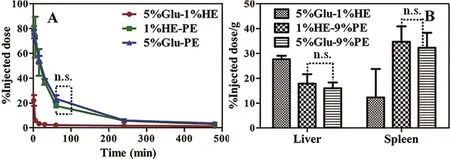
Fig.6–The effect of changing the hydrophilic group in modified phospholipids in the ABC phenomenon induced by the GE.Rats in different groups were given the 1%HE-B.7 d later,each group was assigned to the 9%PE(5µmol phospholipid/kg).For the control group,the first injection was the 5%Glu.n=3.(A)The Plasma concentration of the second dose of the 9%PE.(B)Tissue concentration of the second dose of the 9%PE.Each value represents the mean±SD of three animals.n.s.P>0.05.
In our work,we find that the first injection of the GE can induce theABC phenomenon of the second dose of the PE.This is the first report to show the inf l uence of the second dose of the PE by the first dose of the GE.However,the first injection of the PEGylated liposome cannot induce the ABC phenomenon of the second administration of the polyglycerin coated liposome[33].These results revealed that the long circulation carriers such as PEGylated nanoemulsions,which can amplify some weak signal of immunology changes,can be a good ABC phenomenon detector.Moreover,the all-sided cross injection regimen with the PEGylated nanocarriers should be done in a preclinical study of new materials modified nanocarriers.
4. Conclusion
In this study,we confirm that the first dose of the GE can induce the ABC phenomenon of the second dose of the PE.One of the mechanisms is that the KCs in liver can obtain the immune signal from the polyhydroxy structure and then increase the body clearance ability to the second dose of the PE.Our results revealed that the polycarboxyl structure in modified compound can circumvent the ABC phenomenon.The classical pathway activation is important for the ABC phenomenon.In addition,preclinical study of new nanocarriers materials should do the all-sided cross injection regimen with PEGylated nanocarriers.In the future,we plan to study the interaction between the inmmune system and the compound containing polycarboxyl for better understanding theABC phenomenon.
Conf l ict of interest
The authors declare that there is no conf l icts of interest.
Acknowledgements
This research was supported by the National Natural Science Foundation of China(Grant Nos.81072602,81373334).
[1]Abuchowski A,McCoy JR,Palczuk NC,et al.Effect of covalent attachment of polyethylene glycol on immunogenicity and circulating life of bovine liver catalase.J Biol Chem 1977;252:3582–3586.
[2]Gref R,Lück M,Quellec P,et al.Stealth’corona-core nanoparticles surface modified by polyethylene glycol(PEG):inf l uences of the corona(PEG chain length and surface density)and of the core composition on phagocytic uptake and plasma protein adsorption.Colloids Surf B Biointerfaces 2000;18:301–313.
[3]Bose RJ,Soo-Hong L,Hansoo P,et al.Biofunctionalized nanoparticles:an emerging drug delivery platform for various disease treatments.Drug Discov Today 2016;21:1303–1312.
[4]Dams ET,Laverman P,Oyen WJ,et al.Accelerated blood clearance and altered biodistribution of repeated injections of sterically stabilized liposomes.J Pharmacol Exp Ther 2000;292:1071–1079.
[5]Laverman P,Carstens MG,Boerman OC,et al.Factors affecting the accelerated blood clearance of polyethylene glycol-liposomes upon repeated injection.J Pharmacol Exp Ther 2001;298:607–612.
[6]Ishida T,Maeda R,Ichihara M,et al.The accelerated clearance on repeated injection of pegylated liposomes in rats:laboratory and histopathological study.Cell Mol Biol Lett 2002;7:286.
[7]Ishida T,Maeda R,Ichihara M,et al.Accelerated clearance of PEGylated liposomes in rats after repeated injections.J Control Release 2003;88:35–42.
[8]Zhao Y,Wang C,Wang L,et al.A frustrating problem:accelerated blood clearance of PEGylated solid lipid nanoparticles following subcutaneous injection in rats.Eur J Pharm Biopharm 2012;81:506–513.
[9]Zhao Y,Wang L,Yan M,et al.Repeated injection of PEGylated solid lipid nanoparticles induces accelerated blood clearance in mice and beagles.Int J Nanomedicine 2012;7:2891–2900.
[10]Shukla S,Dorand RD,Myers JT,et al.Multiple administrations of viral nanoparticles alter in vivo behavior–insights from intravital microscopy.ACS Biomater Sci Eng 2016;2:829–837.
[11]Sakai H,Masada Y,Horinouchi H,et al.Physiological capacity of the reticuloendothelial system for the degradation of hemoglobin vsicles(artificial oxygen carriers)after massive intravenous doses by daily repeated infusions for 14 days.J Pharmacol Exp Ther 2004;311:874–884.
[12]Taguchi K,Urata Y,Anraku M,et al.Hemoglobin vesicles,polyethylene glycol(PEG)ylated liposomes developed as a red blood cell substitute,do not induce the accelerated blood clearance phenomenon in mice.Drug Metab Dispos 2009;37:2197–2203.
[13]Taguchi K,Maruyama T,Iwao Y,et al.Pharmacokinetics of single and repeated injection of hemoglobin-vesicles in hemorrhagic shock rat model.J Control Release 2009;136:232–239.
[14]Naeem S,Kiew LV,Yong CL,et al.Drug delivery and innovative pharmaceutical development in mimicking the red blood cell membrane.Rev Chem Eng 2015;31:491–508.
[15]Rao L,Bu LL,Xu JH,et al.Red blood cell membrane as a biomimetic nanocoating for prolonged circulation time and reduced accelerated blood clearance.Small 2015;11:6225–6236.
[16]Okuda T,Kawakami S,Akimoto N,et al.PEGylated lysine dendrimers for tumor-selective targeting after intravenous injection in tumor-bearing mice.J Control Release 2006;116:330–336.
[17]Romberg B,Oussoren C,Snel CJ,et al.Pharmacokinetics of poly(hydroxyethyl-l-asparagine)-coated liposomes is superior over that of PEG-coated liposomes at low lipid dose and upon repeated administration.BBA Biomembr 2007;1768:737–743.
[18]Ishihara T,Maeda T,Sakamoto H,et al.Evasion of the accelerated blood clearance phenomenon by coating of nanoparticles with various hydrophilic polymers.Biomacromolecules 2010;11:2700–2706.
[19]Kierstead PH,Okochi H,Venditto VJ,et al.The effect of polymer backbone chemistry on the induction of the accelerated blood clearance in polymer modified liposomes.J Control Release 2015;213:1–9.
[20]Xu H,Wang KQ,Deng YH,et al.Effects of cleavable PEG-cholesterol derivatives on the accelerated blood clearance of PEGylated liposomes.Biomaterials 2010;31:4757–4763.
[21]Hara E,Ueda M,Kim CJ,et al.Suppressive immune response of poly–(sarcosine)chains in peptide–nanosheets in contrast to polymeric micelles.J Pept Sci 2014;20:570–577.
[22]Yang W,Liu SJ,Bai T,et al.Poly(carboxybetaine)nanomaterials enable long circulation and prevent polymer-specific antibody production.Nano Today 2014;9:10–16.
[23]Li Y,Liu R,Yang J,et al.Enhanced retention and anti-tumor efficacy of liposomes by changing their cellular uptake and pharmacokinetics behavior.Biomaterials 2015;41:1–14.
[24]Li Y,Zhang X.Zwitterionic poly(carboxybetaine)modified liposomes enhancing tumor therapy without accelerated blood clearance phenomenon.J Control Release 2015;213:e125.
[25]Lowe S,O’Brien-Simpson NM,Connal LA.Antibiofouling polymer interfaces:poly(ethylene glycol)and other promising candidates.Polymer Chem UK 2015;6:198–212.
[26]Judge A,McClintock K,Phelps JR,et al.Hypersensitivity and loss of disease site targeting caused by antibody responses to PEGylated liposomes.Mol Ther 2006;13:328–337.
[27]Ishihara T,Takeda M,Sakamoto H,et al.Accelerated blood clearance phenomenon upon repeated injection of PEG-modified PLA-nanoparticles.Pharm Res Dordr 2009;26:2270–2279.
[28]Zhu ZS,Xie C,Liu Q,et al.The effect of hydrophilic chain length and iRGD on drug delivery from poly(εcaprolactone)-poly(N-vinylpyrrolidone)nanoparticles.Biomaterials 2011;32:9525–9535.
[29]Chen DQ,Liu WH,Shen Y,et al.Effects of a novel pH-sensitive liposome with cleavable esterase-catalyzed and pH-responsive double smart mPEG lipid derivative on ABC phenomenon.Int J Nanomedicine 2011;6:2053–2061.
[30]Guo H,Yang CL,Hu ZP,et al.Ethylene glycol oligomer modified-sodium alginate for efficiently improving the drug loading and the tumor therapeutic effect.J Mater Chem B 2013;1:5933–5941.
[31]Matsui H,Ueda M,Hara I,et al.Precise control of nanoparticle surface by host–guest chemistry for delivery to tumor.RSC Adv 2015;5:35346–35351.
[32]Zhang Q,Deng CF,Fu Y,et al.Repeated administration of hyaluronic acid coated liposomes with improved pharmacokinetics and reduced immune response.Mol Pharm 2016;13:1800–1808.
[33]Abu Lila AS,Nawata K,Shimizu T,et al.Use of polyglycerol(PG),instead of polyethylene glycol(PEG),prevents induction of the accelerated blood clearance phenomenon against long-circulating liposomes upon repeated administration.Int J Pharm 2013;456:235–242.
[34]Abu Lila AS,Uehara Y,Ishida T,et al.Application of polyglycerol coating to plasmid DNA lipoplex for the evasion of the accelerated blood clearance phenomenon in nucleic acid delivery.J Pharm Sci 2014;103:557–566.
[35]Maruyama K,Okuizumi S,Ishida O,et al.Phosphatidyl polyglycerols prolong liposome circulation in vivo.Int J Pharm 1994;111:103–107.
[36]Ishida T,Ichihara M,Wang XY,et al.Spleen plays an important role in the induction of accelerated blood clearance of PEGylated liposomes.J Control Release 2006;115:243–250.
[37]Ishida T,Syuntaro K,Hiroshi K.The contribution of phagocytic activity of liver macrophages to the accelerated blood clearance(ABC)phenomenon of PEGylated liposomes in rats.J Control Release 2008;126:162–165.
[38]Ichihara M,Shimizu T,Imoto A,et al.Anti-PEG IgM response against PEGylated liposomes in mice and rats.Pharmaceutics 2010;3:1–11.
[39]Wang L,Wang CL,Jiao J,et al.Tolerance-like innate immunity and spleen injury:a novel discovery via the weekly administrations and consecutive injections of PEGylated emulsions.Int J Nanomedicine 2014;9:3645.
[40]Hara E,Ueda M,Makino A,et al.Factors inf l uencing in vivo disposition of polymeric micelles on multiple administrations.ACS Med Chem Lett 2014;5:873–877.
[41]Semple SC,Harasym TO,Clow KA,et al.Immunogenicity and rapid blood clearance of liposomes containing polyethylene glycol-lipid conjugates and nucleic acid.J Pharmacol Exp Ther 2005;312:1020–1026.
[42]Koide H,Asai T,Hatanaka K,et al.T cell-independent B cell response is responsible for ABC phenomenon induced by repeated injection of PEGylated liposomes.Int J Pharm 2010;392:218–223.
[43]Shimizu T,Ishida T,Kiwada H.Transport of PEGylated liposomes from the splenic marginal zone to the follicle in the induction phase of the accelerated blood clearance phenomenon.Immunobiology 2013;218:725–732.
[44]Ishida T,Ichikawa T,Ichihara M,et al.Effect of the physicochemical properties of initially injected liposomes on the clearance of subsequently injected PEGylated liposomes in mice.J Control Release 2004;95:403–412.
[45]Ishida T,Atobe K,Wang XY,et al.Accelerated blood clearance of PEGylated liposomes upon repeated injections:effect of doxorubicin-encapsulation and high-dose first injection.J Control Release 2006;115:251–258.
[46]Ishida T,Ichihara M,Wang XY,et al.Injection of PEGylated liposomes in rats elicits PEG-specific IgM,which is responsible for rapid elimination of a second dose of PEGylated liposomes.J Control Release 2006;112:15–25.
[47]Ishida T,Wang XY,Shimizu T,et al.PEGylated liposomes elicit an anti-PEG IgM response in a T cell-independent manner.J Control Release 2007;122:349–355.
[48]Kaminskas LM,McLeod VM,Porter CJH,et al.Differences in colloidal structure of PEGylated nanomaterials dictate the likelihood of accelerated blood clearance.J Pharm Sci 2011;100:5069–5077.
[49]Hashimoto Y,Shimizu T,Abu Lila AS,et al.Relationship between the concentration of anti-polyethylene glycol(PEG)immunoglobulin M(IgM)and the intensity of the accelerated blood clearance(ABC)phenomenon against PEGylated liposomes in mice.Biol Pharm Bull 2015;38:417–424.
[50]Ishida T,Kashima S,Kiwada H.The contribution of phagocytic activity of liver macrophages to the accelerated blood clearance(ABC)phenomenon of PEGylated liposomes in rats.J Control Release 2008;126:162–165.
[51]Sperling C,Schweiss RB,Streller U,et al.In vitro hemocompatibility of self-assembled monolayers displaying various functional groups.Biomaterials 2005;26:6547–6557.
[52]Arima Y,Toda M,Iwata M.Complement activation on surfaces modified with ethylene glycol units.Biomaterials 2008;29:551–560.
[53]Jiskoot W,van Schie RMF,Carstens MG,et al.Immunological risk of injectable drug delivery systems.Pharm Res Dordr 2009;26:1303–1314.
[54]Salvador-Morales C,Zhang LF,Langer R,et al.Immunocompatibility properties of lipid-polymer hybrid nanoparticles with heterogeneous surface functional groups.Biomaterials 2009;30:2231–2240.
杂志排行
Asian Journal of Pharmacentical Sciences的其它文章
- GUIDE FOR AUTHORS
- Original Research Paper Pulmonary delivery of liposomal dry powder inhaler formulation for effective treatment of idiopathic pulmonary fibrosis
- Original Research Paper Preparation of poly(lactide-co-glycolide)microspheres and evaluation of pharmacokinetics and tissue distribution of BDMC-PLGA-MS in rats
- Original Research Paper Intranasal administration of carbamazepineloaded carboxymethyl chitosan nanoparticles for drug delivery to the brain
- Original Research Paper Association between the physical stability of flurbiprofen suspension and the interaction of HPMC/SDS
- Original Research Paper Validation of kinetic modeling of progesterone release from polymeric membranes
